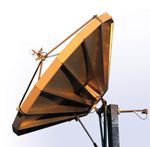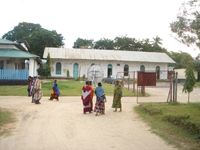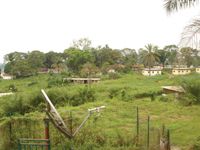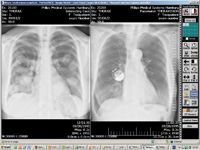GSK: Clinical Trials, African Style
Neil Darwent and Roger Cooper of GSK Biologicals talk to Pharm Exec Europe about the company's new, state-of-the-art approach to clinical trials in Africa.

In a bid to bring a malaria vaccine to market, GSK Biologicals has established clinical trials across 11 sites in seven countries within the African 'malaria belt.' However, the lack of a communications and technology infrastructure, not to mention electricity, in these areas, meant the trials were set to progress at a much slower pace if 'traditional' methods were used to collect the data; particularly when approximately 16,000 baby and young infant patients are expected to participate in the trials.
With funding from the Bill and Melinda Gates Foundation, GSK Biologicals developed a ruggedised technology infrastructure capable of transmitting x-rays and data directly from the African locations, via a NSS-7 satellite, to a ground station in Europe. The medical data is then reviewed by a panel of independent radiologists and the results transmitted back within a 12-hour period.

GSK's Neil Darwent, Director of Information Technology, and Roger Cooper, Project Manager, Global Clinical R&D and Vaccine Development, talk to Pharm Exec Europe about some of the challenges and hopes surrounding this innovative project.
PEE: How did the decision to use satellite technology come about and what were the cost implications?Roger Cooper: In 2007, one of our clinical operations people was visiting potential sites in Africa with a view to teaching staff about the electronic data capture system and to test out the viability of a communications solution; she went equipped with a portable satellite terminal and a 3G mobile phone. She discovered that the 3G phone system just doesn't exist over there, unless you're in major population areas. The sites we have chosen are several hours away from big cities, on dirt roads; they don't have telephones, they don't have copper wire. The only viable way to collect the data quickly and accurately is via a satellite link.

Neil Darwent: The study is set to last 4-5 years, and if there is a local cable infrastructure in place within that time, we could switch to it quite easily. But in terms of response time and the time it takes to send the x-ray images, we can get the performance we need from the satellite link. The x-ray images are 10-20 megabytes in size, so we never had an expectation that they would be transferred in a matter seconds or even a few minutes. We've done many tests and it takes about 30 minutes to send an x-ray; individual sites will be sending between one and three x-rays per night.
As far as cost in concerned, the value of the trial is enormous, but the cost of the technology is falling. And a crucial factor is the number of sites. If this project had only involved one or two sites, it probably wouldn't have been viable, because approximately 80% of the cost has been invested in the overall infrastructure, with 20% on a site-by-site basis. With 11 sites, it becomes possible to spread that cost, and when we add a twelth site, which we are doing for a different trial, the incremental cost is just a few thousand Euros.
What challenges have you faced in setting up the satellite system?RC: The challenge initially was in working with a diverse collection of countries, agencies and peoples; GE Satlynx has local agents on the ground in many countries in Africa, and one of the things we needed to do was to ensure good co-ordination between the people in the study centres doctors, IT people and the Satlynx folks locally and in western Europe.
Another issue we faced was dealing with the authorities; getting telecommunications licences could be a long and somewhat tortuous process. In Malawi, where we're just finishing up the installation, we had a four-month delay in getting the licence, and the importation of the equipment could only happen after that.

The Bill and Melinda Gates Foundation is waging a very high profile fight against malaria. What kind of pressures has this brought?RC: The Gates Foundation was responsible for funding the x-ray side of the project they provided the equipment, the training and so on and GSK has funded the satellite infrastructure.
ND: The funding from Bill and Melinda Gates is exactly that funding. However, Bill Gates was with us in Belgium a few weeks ago and he was personally putting enormous pressure on the project, asking when can you start, can you do this four-year study in three years, that kind of thing; he's very committed to getting this vaccine to market as soon as possible.
There was a time last year when we were on the critical path in terms of getting the infrastructure in place, but that's just like a normal IT project. There's no denying, however, this is a high visibility project.
Addressing Disparities in Psoriasis Trials: Takeda's Strategies for Inclusivity in Clinical Research
April 14th 2025LaShell Robinson, Head of Global Feasibility and Trial Equity at Takeda, speaks about the company's strategies to engage patients in underrepresented populations in its phase III psoriasis trials.
Beyond the Prescription: Pharma's Role in Digital Health Conversations
April 1st 2025Join us for an insightful conversation with Jennifer Harakal, Head of Regulatory Affairs at Canopy Life Sciences, as we unpack the evolving intersection of social media and healthcare decisions. Discover how pharmaceutical companies can navigate regulatory challenges while meaningfully engaging with consumers in digital spaces. Jennifer shares expert strategies for responsible marketing, working with influencers, and creating educational content that bridges the gap between patients and healthcare providers. A must-listen for pharma marketers looking to build trust and compliance in today's social media landscape.
Pfizer, GSK Gain ACIP Recommendations for RSV and Meningococcal Vaccines
April 18th 2025The Centers for Disease Control and Prevention’s Advisory Committee on Immunization Practices voted to expand access to Pfizer’s respiratory syncytial virus vaccine Abrysvo for high-risk adults in their 50s and voted in favor of GSK’s meningococcal vaccine, Penmenvy, for streamlined adolescent protection.